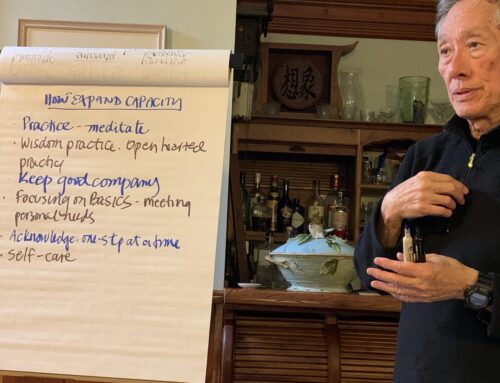
Image by Abby Lanes
I’ve been doing an exercise with my students lately where we look closely at our judgments.
What is a judgment, anyway? What I’ve found is that a judgment is any thought based on a belief. So, what is a belief? Well, it turns out beliefs are everywhere. If it’s a thought that can change, it’s probably a belief. Think about it. Let’s look at something we can all agree on, say, the color green. If I told you that I was wearing a green sweater right now, you’d have an image of it in your head, right?
But there are many shades of green—we go to so much effort trying to name them all, but still fall short—apple green, artichoke, asparagus, avocado, bright green, Cal Poly green, chartreuse, cyan, dark green, dark olive green, dark spring green, Dartmouth green, emerald, fern green, forest green, green, green-yellow, harlequin, honeydew, hunter green, India green, Islamic green, jungle green, Kelly green, lawn green, lime, lime green, mantis, Malachite, mint, mint cream, office green, olive, olive drab, Pakistan green, Paris green, Persian green, phthalo green, pigment green, pine green, pistachio, sea green, shamrock green, spring bud, spring green, teal, viridian, yellow-green. Which shade of green is this sweater, or do we need to invent another one for it?
And who is to say that even if we can agree on a name for the shade, that we’re both seeing the same thing? Maybe my green looks a little like your red, who knows?
So ‘green’ is a belief. It’s an idea that we’ve all agreed on, but that doesn’t stop it from being an idea.
Here’s another one: my name is Jamie. I should know, people have been calling me that all my life, and I’ve even put it on my website. I’m pretty sure that my name is Jamie. But how do I really know? I’m also a father (another belief), and I remember it taking us two weeks to come up with our son’s name. But how did we know? We didn’t. We couldn’t. We just needed something to yell authoritatively when he was being naughty. And to say lovingly the rest of the time, but the yelling authoritatively thing is important—be sure to practice it before you go naming anyone! So if his name is a belief, I suppose mine must be too.
And it goes on; say I’m looking at a wall. It’s a wall, right? That’s pretty straightforward. Maybe. Am I looking at the wall or the paint? Does the wall have texture? Am I looking at that? If I’m looking at the texture, am I looking at the wall or the gaps that make the texture? Is there a crack in it? Again, is it a crack or is it air? Am I looking at darkness? And am I looking at brick, cement, wood? Mortar? The more I look, the more it breaks down, and every breakdown is another belief, and another, and another.
The truth is, everything I see is what I think it is. My whole perception of the world is constructed entirely of beliefs; of judgments.
That’s what perception is, after all: my five senses receive raw data and transport that information to my brain; the brain—depending entirely on how it already sees the world—dismisses the bulk of this data as irrelevant, and processes the rest through a lens that already knows what it wants to see. My beliefs define what I experience. My whole experience of the world is one big judgment!
What would life be like without judgment? Would it even be possible? Surely we need to judge that we’re hungry or that we shouldn’t step over that cliff. How could you drive if your judgment didn’t tell you that is a stop sign and that is a pedestrian?
The short answer is, how would I know? Like you, I live in judgment all the time. However, I have occasionally been able to still my mind enough to be able to notice that small space between sensation and perception. It is a wide open space of awareness that is beyond perception. It is a state of wonder. We all have that space: if you have sensation and if you have perception, you have the space between.
Allow yourself to be still. Really still. Focus just on one thing, maybe the breath since it’s sitting with you right now. Just focus on that place at the tip of the nostrils where you can feel it coming in cool and going out warm. Just that. When you notice a thought has come—and many will—thank it kindly for its existence and let it go on its way, knowing it is just another belief, another judgment; knowing that if you really need that thought, it’s bound to return sometime. Come back to the breath. Don’t force it, just breathe normally. When you notice a sensation—an itch, a pain, whatever—just let it be; recognize that in calling it an itch or a pain that you’ve entered once again into belief, into judgment. If you find that sensation too distracting, spend a few moments exploring it without naming it. What is this feeling? Where does it go? What does it do? Then return, as ever, to the breath. The tip of the nostrils. In. Out. In. Out. Cool. Warm. Cool. Warm. Just notice. Just notice.
And who knows? You may, at some point, find yourself in that small, yet infinite, space between sensation and perception. It’s a nice place to be.



